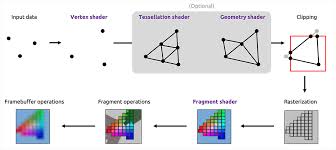Vertex Attribute Flag: Unlocking the Power of Efficient Graphics Rendering
Understanding the Role of Vertex Attribute Flags in Modern Graphics

The term “vertex attribute flag” refers to a crucial element in modern computer graphics that controls how vertex data is utilized during rendering. These flags manage the attributes of vertices, including position, color, texture coordinates, and normals, ensuring efficient data handling and optimized rendering performance. By leveraging vertex attribute flags effectively, developers can significantly enhance the visual quality and responsiveness of 3D applications, from video games to simulations.
What is a Vertex Attribute Flag?
A vertex attribute flag is a setting or mechanism used to define and control the properties of vertices in a 3D graphics pipeline. These attributes are essential for shaders, which process vertex data to generate stunning visuals. Common attributes managed by these flags include:
Position
Defines the vertex’s coordinates in 3D space.
Color
Specifies the vertex’s color values.
Normals
Provide information about the surface’s orientation for lighting calculations.
Texture Coordinates
Map textures onto 3D surfaces.
Vertex attribute flags essentially act as enablers or toggles, determining whether a specific attribute is active during rendering. This granular control helps optimize performance by ensuring that only necessary data is processed.
The Importance of Vertex Attribute Flags
Efficient graphics rendering hinges on how well vertex data is managed. Vertex attribute flags play a pivotal role in this by:
Enhancing Performance
By enabling only the required attributes, unnecessary computations are avoided, leading to faster rendering.
Streamlining Data Management
Flags ensure a structured approach to handling diverse vertex attributes.
Customizing Visuals
Developers can activate specific flags to achieve unique visual effects, such as dynamic lighting or texture blending.
How Vertex Attribute Flags Work
In frameworks like OpenGL, vertex attribute flags are implemented through a combination of functions and buffer configurations. Here’s a simplified overview:
Defining Attributes
Developers use functions like glVertexAttribPointer to specify the format and layout of vertex data.
Enabling Attributes
The glEnableVertexAttribArray function activates specific vertex attributes.
Disabling Attributes
Attributes can be deactivated using glDisableVertexAttribArray when no longer needed.
These steps ensure that the graphics pipeline processes only the data required for a particular rendering task.
Practical Applications of Vertex Attribute Flags
Vertex attribute flags are widely used in various industries and applications:
Video Games
For creating detailed characters, environments, and dynamic effects.
Simulations
To render realistic scenarios in training or research environments.
Virtual Reality
Enhancing immersion by optimizing frame rates and visual fidelity.
Architectural Visualization
Bringing designs to life with accurate lighting and textures.
Optimizing Graphics with Vertex Attribute Flags
To maximize the potential of vertex attribute flags, developers can follow these best practices:
Minimize Attribute Usage
Enable only the attributes required for a specific shader or rendering pass.
Use Efficient Data Formats
Optimize memory usage by selecting compact data formats for attributes.
Leverage Vertex Array Objects (VAOs)
VAOs store the state of vertex attributes, simplifying attribute management and reducing overhead.
Challenges and Solutions
While vertex attribute flags offer numerous benefits, they can also introduce challenges:
Complexity
Managing multiple attributes for large scenes can be daunting.
Debugging Issues
Incorrectly configured flags can lead to rendering artifacts.
Solutions include using debugging tools provided by graphics frameworks and adopting clear naming conventions for attributes.
Future Trends in Vertex Attribute Management
As graphics hardware and software continue to evolve, vertex attribute flags are expected to become more sophisticated. Future advancements may include:
Automated Attribute Optimization
Intelligent systems that dynamically enable or disable attributes based on scene requirements.
Enhanced Shader Compatibility
Improved integration between attribute flags and shader programming languages.
Support for Emerging Technologies
Adapting to innovations like ray tracing and AI-driven rendering techniques.
Conclusion
Vertex attribute flags are a cornerstone of efficient graphics rendering, enabling developers to manage vertex data with precision and flexibility. By understanding and utilizing these flags, you can unlock the full potential of modern graphics pipelines, creating visually stunning and highly optimized applications. Whether you’re working on a cutting-edge video game or a virtual reality experience, mastering vertex attribute flags will give you a competitive edge in the world of 3D graphics.



